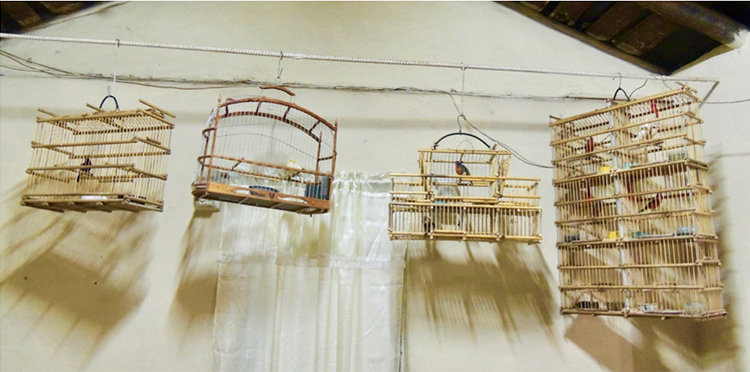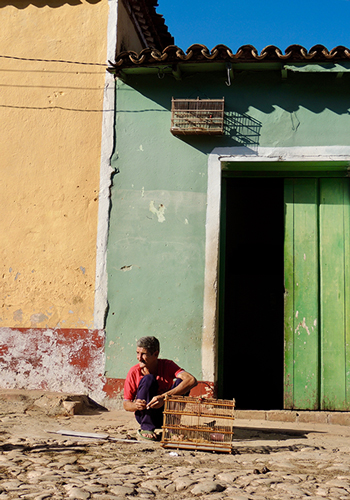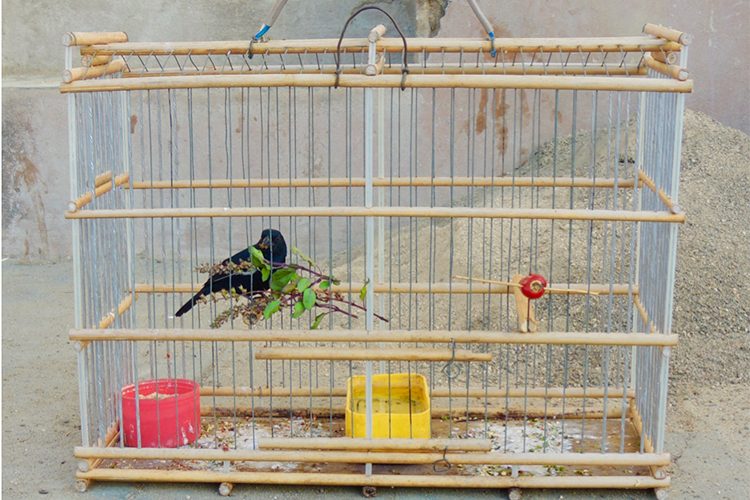As the day begins in the colonial Cuban city of Trinidad, it’s a common sight to see men going about their daily routines with birdcages in hand. Many Trinidadian men have companionship in the form of songbirds, sitting in beautifully crafted cages. Among the vibrant colours, festive sounds, friendly residents, and various religions of the city, it’s quite easy for a new visitor to miss this popular regional culture of songbirds and handmade cages.
Canaries, blackbirds and other birds fill the city with beautiful songs and melodies, which are a great representation of the nature that surrounds this southern city. The songbirds are kept in spacious, handmade birdcages, precisely constructed with a bamboo-like material along with rustproof wires and plastic. With each cage taking two to three days to complete, the process is also considered a hobby for many residents, especially those without regular work and with plenty of free time.
The end product is always something to admire, with even the cheapest cages, costing around 3 CUC (or $3 at $1 to the CUC), displaying an artisanal professionalism comparable to some of the larger, more complex cages, costing around 10 CUC. The types and designs of birdcages are plentiful. There are your standard six-sided cages, ones with elegant arches, others with smooth carvings engraved into the exterior, ones with built-in traps, and even “apartment” style cages separated into sections for four to six songbirds.

Four different birdcage designs on display at the home of a local bird-dealer | Minki Kim
The main purpose of these birdcages is to provide a calm and serene environment for a home and family. As explained by Julio Abrahantes, a 65-year-old retired charter-boat captain, current birdcage hobbyist and bird-trapper, “The tradition is passed down from generation to generation to keep the culture alive”. As such, the songbirds are well fed, given time in the sun, and are even taken along on errands, similar to North Americans with their pet dogs. It’s common to see Trinidadian men walking the streets with a birdcage in hand, only to momentarily hang the bird up on a wall to buy groceries or catch up with friends.

A local Trinidadian man putting the finishing touches on his latest birdcage | Minki Kim
Pets, in general, are extremely common in Trinidad. “If there is no animal or bird, it is not a Trinidadian home”, said Abrahantes, when speaking of the cultural significance of the songbirds and birdcages. “Properly taking care of an animal is now a luxury, which has placed songbirds as the pet of choice because of their low price and free if you can trap them yourself, and high numbers, which increase even more during the bird migrations from Florida”.
Canaries and blackbirds are the most popular (approx. 5 CUC each), while mariposas, painted buntings (approx. 10 CUC), are rarer and aesthetically pleasing to the eye. Mockingbirds and tocoloros, Cuban trogons (the national bird of Cuba), can also be found in Trinidadian homes. Abrahantes said, “Approximately 80% of homes have at least one birdcage” and this estimate is very believable with songbirds adorning the entrances, windows, or family rooms of the majority of homes on any given block.
A visit to one of the Trinidadian bird-dealers shows the depth of the culture with a plethora of bird species and birdcages. Songbirds aside, parakeets, parrots, lovebirds, and even pigeons are bred and raised for eventual sale. Many birdcages of varying designs cover the walls of every room. The aesthetics of the cages seem to balance out any semblances to cramped pet-stores in North America. Going back to the preservation of the culture, it’s quite interesting to see the bird-dealer working with neighbourhood children; teaching them the proper ways to feed, handle, and raise the different birds.

A neighborhood boy learning the trade at the home of a local bird-dealer | Minki Kim
Aside from being present in the home and providing owners with companionship, the songbirds can also earn owners a small income. During the month of March, before the hot summer season takes its course, numerous competitions, exclusively for Cubans, take place to determine the best songbird. The winning bird is judged by the quality of its singing and similarity of its songs to a human whistle. Depending on the state of the economy, the victorious owner can take home a prize of 40 CUC to 100 CUC. Many people can also win money, albeit illegally, by betting on the victor. These competitions are another incentive for owners to properly take care of the songbirds and their cages.
When visiting Trinidad, take the path least taken and explore the culture of songbirds and birdcages to experience a side of the city that many tourists will miss. Visit one of the local bird-dealers, observe a man meticulously constructing a cage, and notice the vast variety of songbirds as you explore the colourful streets. With enough luck and knowing the right people, you might even find yourself at one of the exclusive “underground” songbird competitions.
Travel Journalism & Photography Internship Seminar in Havana and Trinidad, Cuba

